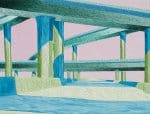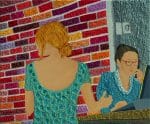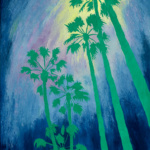Peter Frank
Peter Frank is a well known Los Angeles art critic. This is his review of my Brocade portfolio:
TECHNIQUE AS PLACE – NANCY R WISE
by Peter Frank
Natives of a city see their birthplace differently than do visitors or even long-time transplants. In a sense, it parallels (admittedly at a distance) how one feels about one’s family: the dependable quirks trigger the same deep satisfactions and frustrations, and the changes trigger anxiety and relief by turn. Natives know what needs to be improved, and what needs to stay the same, according to the inner logic of their hometown. Endearment and alienation are two sides of the same coin: you can’t go home again, especially if you’ve never left.
The love-hate relationship Los Angeles natives such as Nancy R Wise have with Southern California is a special case. They are born into a place known for its volatility, its constant and often dramatic societal and natural evolution. A populace – whose taste for fashion cannot outpace its own changing complexion – inhabits a site of frequent natural disaster and equally disruptive social tension. Even the day-today reality of the LA Basin changes markedly not just from hour to hour but from mile to mile. Reyner Banham identified the architecture of Los Angeles as responsive to “four ecologies” (ocean, desert, mountain, plain), and others have noted that, in effect, Angelenos respond to this variety with an outpouring of spectacle, temporary and, well, not as temporary.
Nancy Wise’s paintings do not just echo this web of condition and response, they embody it. The landscapes and peoplescapes she paints are what we readily identify as “quintessential” LA, taking us from the expansive and miraculous (and thus “spectacular”) phenomenon of the freeway overpass to the emotionally modulated – and rapidly evolving – experience of public dining. Rarely does she depict the more cliched face of Los Angeles, and when she does, as in a palm tree painting here and there, she subjects them to the kind of almost hallucinatory distortion – tenebrous silhouettes, washed-out but still brilliant colors – that natives dream.



In fact, Wise subjects everything she pictures to delirious reinterpretation. Wielding what the Abstract Expressionists called a “loaded brush”, she paints as if she is carving, subtracting and adding brushstrokes into designated areas that compile into coherent images. The relationship to abstract expressionism ends here; rather than engage in a paint-flinging theater of the soul, Wise works on her predetermined subjects as if hewing a wood surface or building cloisonné inlay. The signal characteristics of her recent work are its surface, mottled regions interrupted by passages of smoothness, and its jigsaw-like composition, wherein the edges of things contain the insistent accretions of pigment and define discrete structures that quickly but not immediately, identify themselves as faces, objects, swaths of landscape.
As a result, Wise’s paintings look constructed, pieced together, rendered by some tool markedly more aggressive than a paintbrush. They neither picture forth nor reimagine natural and manmade spaces; they recollect them and filter them through a lens so palpable that it is tasted as much as it is seen. The richness of the surfaces – and to a certain extent Wise’s neo-Fauvist color decisions – recall cake icing, to be sure, but does not fall into the optically saccharine; the expanses of carefully accrued strokes take on many textures, evocative of many things, consumable and not.

Wise thus proposes that Los Angeles is a moveable feast, but not always an edible one. (In her restaurant paintings she redoubles this proposition by depicting diners waiting to eat rather than actually eating – the “restaurant experience”, in the local consumer lingo, which obviates the need for actual victuals.) Knowing LA as she does, Wise is as confident in subjecting her birthplace to her vision as she is in admitting that her vision is subject to that same place. In fact, that vision and that place effectively conflate in her paintings. She has set herself adrift in her hometown, and anchors herself repeatedly by capturing what’s around her with incongruous but illuminating gravity. Physical gravity.
Gravity, physical or aesthetic, does not play a central role in the experience of Los Angeles. Edges are sharp here but they are carved out of the sun-fried sky, not out of the paved and blasted earth. Wise sets out not so much to reverse or remedy this as to propose that Los Angeles can be anchored, that something durable can be recognized even in its most delicate structures – its architecture built for earthquakes no less than its inhabitants attuned to the vagaries of fashion and the traffic-challenged remoteness of history and tradition.
Nancy Wise grew up under particular atmospheric conditions, surrounded by particular kinds of buildings, and engaged in particular social rituals. These particulars, her works attest, have modified, but they have not fundamentally changed, much less disappeared. Wise’s paintings manifest her sense of continuity in, and about, a place that the rest of the world regards as ephemeral and unstable. That technique of deep, layered texture insists on a resolute spirit coursing through LA’s veins – the surface equivalent of a river paved over and buried beneath urban development (yes, rather like the Los Angeles River) but flowing as insistently as ever. Wise’s impasto represents faith in a place and a revelation about its soul.